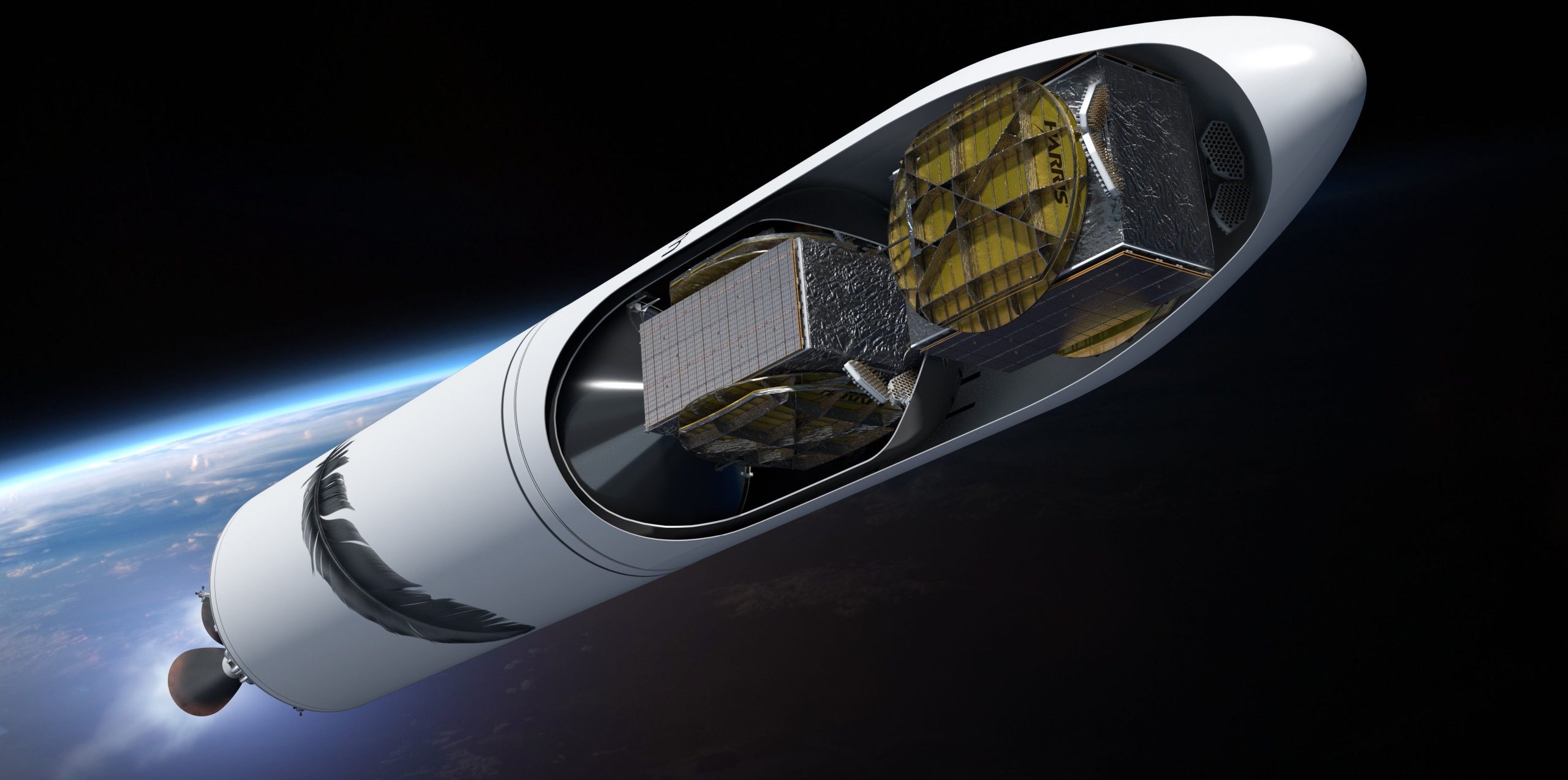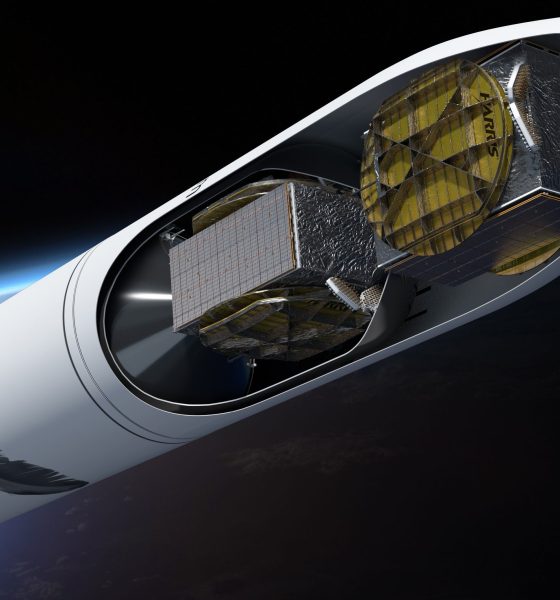

News
Blue Origin teases first New Glenn rocket prototype at Blue Moon lander event
In May 2019, Blue Origin unveiled plans to build and launch “Blue Moon” lunar landers. Five months later, founder Jeff Bezos has announced a proposal for NASA’s Artemis Moon lander program that would augment Blue Moon with hardware from aerospace stalwarts Lockheed Martin, Northrop Grumman, and Draper to land astronauts on the Moon in the 2020s.
On top of that, Bezos also revealed the first unequivocal confirmation that Blue Origin has begun building full-scale prototype hardware for its ambitious New Glenn orbital launch vehicle – in this case, half of a massive carbon fiber payload fairing.
In a press release posted to the company’s website, Blue Origin’s Chief Executive Officer, Bob Smith, stated that “national challenges call for a national response. We are humbled and inspired to lead this deeply committed team that will land NASA astronauts on the Moon.” The national team will be managed with Blue Origin as the principal contractor and “[combine] our partners’ heritage with our advance work on the Blue Moon lunar lander and its BE-7 engine.”
Solving the lunar landing equation
Each company was selected based on a demonstrated area of expertise that solves a very specific piece of the equation that is landing astronauts on the moon. Blue Origin will serve as the primary contractor leading mission engineering and assurance, as well as providing the lunar Descent Element, Blue Moon. Lockheed Martin will provide the reusable Ascent Element vehicle and lead the operations and flight training of the crew, while Northrop Grumman provides the Transfer Element vehicle to deliver Blue Moon to the lunar surface.
Draper’s contribution is integral to mission success. It will provide a navigation system “designed to give crewed missions precise location and navigation data needed for safe and accurate lunar and planetary landings” as outlined in a NASA Space Technology Mission Directorate statement earlier this month. The Draper navigation system is expected to debut during a launch of Blue Origin’s suborbital rocket, New Shepard as proof of concept by year’s end.

Debuting super-heavy rocket hardware
During his IAC presentation, Bezos revealed a video of what is almost certainly the first full-scale prototype hardware of Blue Origin’s reusable New Glenn rocket. In the clip, a massive carbon-composite payload fairing half is moved inside an even larger curing oven located on Blue Origin’s Cape Canaveral, FL campus, offering an incredibly rare glimpse inside the company’s purported New Glenn factory.
New Glenn’s payload fairing will measure 7m (23 ft) wide and roughly 22m (72 ft) tall, dwarfing the 5ish-meter options currently used by SpaceX and ULA. As of now, New Glenn’s payload fairing will be the largest expendable fairing on Earth when it debuts in 2021 or 2022.
Aside from a Blue Moon lander mockup, Blue Origin also brought an entire BE-4 engine to IAC 2019. Seven BE-4s will power New Glenn’s reusable first stage and the United Launch Alliance (ULA) has also selected BE-4 to power its Vulcan booster. Capable of producing roughly 550,000 lbf (2400 kN) of thrust, Blue Origin is slowly but surely qualifying BE-4 for flight and recently began its first full-thrust static fires at the company’s Van Horn, Texas test facilities.
While Bezos’s presentation provided the briefest of views inside Blue Origin’s rocket factory, Space Coast local Julia Bergeron posted a photo on Twitter showing an impressive fleet of cranes hard at work building Blue Origin’s LC-36 New Glenn launch pad in Cape Canaveral, Florida.

Blue Origin is notoriously hesitant to share much of anything about its next-generation New Glenn rocket, so it’s a pleasant surprise to receive even the briefest of glimpses behind the scenes. Combined with Blue’s undeniable rocket propulsion expertise and shrewdly political (albeit unsavory) approach to industry collaboration, the company is clearly here to stay and is certainly doing everything it can to give NASA an offer it simply can’t refuse.
Check out Teslarati’s Marketplace! We offer Tesla accessories, including for the Tesla Cybertruck and Tesla Model 3.

News
Tesla FSD fleet is nearing 7 billion total miles, including 2.5 billion city miles
As can be seen on Tesla’s official FSD webpage, vehicles equipped with the system have now navigated over 6.99 billion miles.

Tesla’s Full Self-Driving (Supervised) fleet is closing in on almost 7 billion total miles driven, as per data posted by the company on its official FSD webpage.
These figures hint at the massive scale of data fueling Tesla’s rapid FSD improvements, which have been quite notable as of late.
FSD mileage milestones
As can be seen on Tesla’s official FSD webpage, vehicles equipped with the system have now navigated over 6.99 billion miles. Tesla owner and avid FSD tester Whole Mars Catalog also shared a screenshot indicating that from the nearly 7 billion miles traveled by the FSD fleet, more than 2.5 billion miles were driven inside cities.
City miles are particularly valuable for complex urban scenarios like unprotected turns, pedestrian interactions, and traffic lights. This is also the difference-maker for FSD, as only complex solutions, such as Waymo’s self-driving taxis, operate similarly on inner-city streets. And even then, incidents such as the San Francisco blackouts have proven challenging for sensor-rich vehicles like Waymos.
Tesla’s data edge
Tesla has a number of advantages in the autonomous vehicle sector, one of which is the size of its fleet and the number of vehicles training FSD on real-world roads. Tesla’s nearly 7 billion FSD miles then allow the company to roll out updates that make its vehicles behave like they are being driven by experienced drivers, even if they are operating on their own.
So notable are Tesla’s improvements to FSD that NVIDIA Director of Robotics Jim Fan, after experiencing FSD v14, noted that the system is the first AI that passes what he described as a “Physical Turing Test.”
“Despite knowing exactly how robot learning works, I still find it magical watching the steering wheel turn by itself. First it feels surreal, next it becomes routine. Then, like the smartphone, taking it away actively hurts. This is how humanity gets rewired and glued to god-like technologies,” Fan wrote in a post on X.
News
Tesla starts showing how FSD will change lives in Europe
Local officials tested the system on narrow country roads and were impressed by FSD’s smooth, human-like driving, with some calling the service a game-changer for everyday life in areas that are far from urban centers.

Tesla has launched Europe’s first public shuttle service using Full Self-Driving (Supervised) in the rural Eifelkreis Bitburg-Prüm region of Germany, demonstrating how the technology can restore independence and mobility for people who struggle with limited transport options.
Local officials tested the system on narrow country roads and were impressed by FSD’s smooth, human-like driving, with some calling the service a game-changer for everyday life in areas that are far from urban centers.
Officials see real impact on rural residents
Arzfeld Mayor Johannes Kuhl and District Administrator Andreas Kruppert personally tested the Tesla shuttle service. This allowed them to see just how well FSD navigated winding lanes and rural roads confidently. Kruppert said, “Autonomous driving sounds like science fiction to many, but we simply see here that it works totally well in rural regions too.” Kuhl, for his part, also noted that FSD “feels like a very experienced driver.”
The pilot complements the area’s “Citizen Bus” program, which provides on-demand rides for elderly residents who can no longer drive themselves. Tesla Europe shared a video of a demonstration of the service, highlighting how FSD gives people their freedom back, even in places where public transport is not as prevalent.
What the Ministry for Economic Affairs and Transport says
Rhineland-Palatinate’s Minister Daniela Schmitt supported the project, praising the collaboration that made this “first of its kind in Europe” possible. As per the ministry, the rural rollout for the service shows FSD’s potential beyond major cities, and it delivers tangible benefits like grocery runs, doctor visits, and social connections for isolated residents.
“Reliable and flexible mobility is especially vital in rural areas. With the launch of a shuttle service using self-driving vehicles (FSD supervised) by Tesla in the Eifelkreis Bitburg-Prüm, an innovative pilot project is now getting underway that complements local community bus services. It is the first project of its kind in Europe.
“The result is a real gain for rural mobility: greater accessibility, more flexibility and tangible benefits for everyday life. A strong signal for innovation, cooperation and future-oriented mobility beyond urban centers,” the ministry wrote in a LinkedIn post.
News
Tesla China quietly posts Robotaxi-related job listing
Tesla China is currently seeking a Low Voltage Electrical Engineer to work on circuit board design for the company’s autonomous vehicles.

Tesla has posted a new job listing in Shanghai explicitly tied to its Robotaxi program, fueling speculation that the company is preparing to launch its dedicated autonomous ride-hailing service in China.
As noted in the listing, Tesla China is currently seeking a Low Voltage Electrical Engineer to work on circuit board design for the company’s autonomous vehicles.
Robotaxi-specific role
The listing, which was shared on social media platform X by industry watcher @tslaming, suggested that Tesla China is looking to fill the role urgently. The job listing itself specifically mentions that the person hired for the role will be working on the Low Voltage Hardware team, which would design the circuit boards that would serve as the nervous system of the Robotaxi.
Key tasks for the role, as indicated in the job listing, include collaboration with PCB layout, firmware, mechanical, program management, and validation teams, among other responsibilities. The role is based in Shanghai.
China Robotaxi launch
China represents a massive potential market for robotaxis, with its dense urban centers and supportive policies in select cities. Tesla has limited permission to roll out FSD in the country, though despite this, its vehicles have been hailed as among the best in the market when it comes to autonomous features. So far, at least, it appears that China supports Tesla’s FSD and Robotaxi rollout.
This was hinted at in November, when Tesla brought the Cybercab to the 8th China International Import Expo (CIIE) in Shanghai, marking the first time that the autonomous two-seater was brought to the Asia-Pacific region. The vehicle, despite not having a release date in China, received a significant amount of interest among the event’s attendees.








